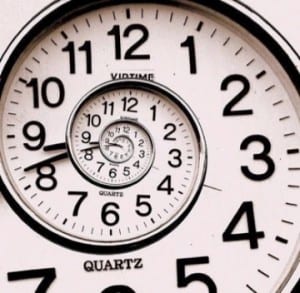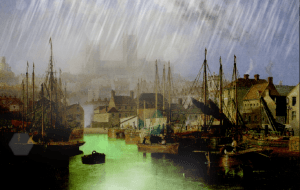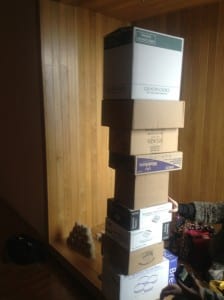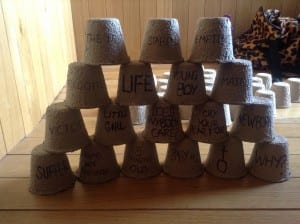‘Feminism is the radical notion that women are human beings’
Fisanick, Christina (2007) Feminism Opposing Viewpoints Series, Greenhaven Press
Our piece developed when we performed it to our fellow peers and Dan. The general feedback we had was questioning the relationship between us (Sam, Kirsty and myself) and Tom. The use of Tom sketching and making copies of us and him being makes him become a superior and the observer, watching the minor details that us (women) do to make ourselves look good.
The link between Tom and us in our performance shows the status and power that Tom has, him sitting on a chair watching us, implying the status that ‘men’ have on women. He is observing us, creating pictures and images of us with make up on, suggesting the illusion and the beauty that men see on women. Identifying the key features that women highlight when wearing make up, particularly when going on a night out, most women ‘dress to impress‘ making the opposite sex become attracted to them.
With us applying make up on, it suggests that we are applying a mask to make an idyllic representation of ourselves to be observed by other men. This is why we stand up and walk to the Venus de Milo drawing, and remove our mask highlighting that we are just copies of ourselves when we have make-up on, removing the make-up shows the true beauty and the naturalistic face, creating a honest picture of ourselves.
The image of women to look good is pressurized by society through the use of magazines, television, radio etc. It becomes the ‘norm’ for women to to wear make-up. If a woman doesn’t wear make-up you tend to get the questions like ‘why are you not wearing make-up?‘. Why should we be questioned? Why is it, when we don’t wear make-up we feel naked? Because of the pressure to look good and to be an exhibition of ourselves we are creating the concealed illusion copies of ourselves.
Category: Research
Progression
This week our group met at the cafe and discussed and experimented with some ideas developing from our main aim of putting on an exhibition outside the cafe. One of our ideas was to portray the quotes we have heard from the visitors of the cafe on the steps outside the cafe with chalk. However, from trying this out we realised it didn’t look as clear or effective as we imagined and as a result, developed this idea of using the text on a cafe menu whilst Jennie and Gabriel recite the quotes they have heard which contrasts the subtle with the obvious.
Another idea was for me to stand or sit in a glass box drinking tea to symbolise the people in the cafe are shut off from everyone else and unobservant of the other people in the cafe. It would also make the visitors of our exhibition observe the visitor in the cafe just as we have been doing on a weekly basis. However, we were unable to get permission to use one of the glass cases which the Collection gallery owns as they are too expensive and are already used for displaying artefacts in the museum. Therefore we decided to use a black wooded platform instead and represent the staff in the cafe as the staff are just as important as the customers in the observation of the cafe. As a result, it made me think whilst we were occupied observing and focusing on the customers we didn’t pay attention to the staff and therefore having me dressed as a staff member on a platform quoting things we’ve heard them saying, it makes the visitors of our exhibition notice them too.
As we are exhibiting things from the cafe, such as a cake stand holding cupcakes and a tea set in a glass plinth, we also tried to think of other things we could represent from the cafe. The main one we realised was the menu which is written on massive chalkboard inside the cafe. Therefore we have created our own chalkboard to write our own specials on for our performance. For example, it may read ‘Today’s specials are: Gabriel talking to himself as the reader, Jennie talking to herself as the working man, Francesca stood on a platform’. This therefore uses the same device of the cafe but has our own twist on it.
Another initial idea we had was to put lettering on the windows of the cafe and the education room to show ‘the observation’ and ‘the mimic’. As materials for this were hard to find for example plastic window lettering, we decided to make our own out of A4 coloured card and laminate it to make it look professional. The coloured card reflects the colours of the education room and makes the words stand out from the tinted windows, especially as the actions in the education window will need to be made aware of and obvious to the visitors who may not notice Shellie and Holly otherwise. The bright, large colours will also contrast with the subtle actions from me Gabriel and Jennie.
Throughout our rehearsals and planning process, trying to access ladders to put up string to connect the cafe and education room buildings to mirror the image in the painting, ‘Bound By Love’ had proved difficult. Unfortunately, even though the painting was one of our first inspirations for our piece, we decided it would be too much of a risk to attempt to do it on the day of our performance without any trial runs and we actually realised the string would not be necessary anymore as it no longer connected with the rest of our piece.
“The world of Film…”
Multimedia or video is being more widely used as an art form. As Lori Zippay says in Artists’ Video, “Video may be the emblematic art – making form for the late twentieth century” (1991 p3). And now in the early twenty-first century a media form that is still greatly used if not more. You need only to step from the room our performance is in, to see two video art pieces. Hopefully our video, along with our ‘Instagram’ pictures, and now our Instagram pictures of the Venus de Milo, will hopefully make this connection and enlighten the public. Would this add to the culture of Lincoln? Zippay states that the result of a video in an artistic context is “a singularly dynamic engagement with issues of subjectivity, culture and image making” (Zippay 1991 p3). This is exactly what we hope to achieve by having this video on-going through our performance.
Usually video is associated with contemporary art but would it make a difference having a video in a less contemporary environment highlighting some core art values?
All art is idealised. It is painted or drawn to make a ‘copy’ of the original, sometimes or rather more likely with artistic merit. With the Brayford painting the information by the side of the painting said that it had been idealised. So, no, the swans weren’t swimming exactly there and they may well have not been a lovely artistic mist consuming the cathedral in the distance. It may not have even been a bright day. Therefore, the reason behind the video is to transform form this image:

To this:
This will hopefully make our audience think, or make them aware of this idealistic approach to art.
However as we said before, this very painting was removed and the gallery where the performance will be based has been changed. However the replacement paintings as stated before couldn’t be more relevant. They are copies or ‘idealised drawings’ of the Venus de Milo by a local Lincolnshire artist born at around the same time as the Brayford Pool and Cathedral painting was produced.
Hopefully this collaboration between our live art and the video can enlighten the audience.
“museums are invested in challenging those heretofore unexamined principles of organization, shifting from display to experience and inviting a more collaborative process with visitors.” (Bennett p4, 2013). And indeed galleries. Especially the Usher. This point here by Bennett really grounds where our inspiration comes from. Why sit back and just enjoy art? Let’s make everyone think about what they are looking at and what it means. There is even another provocation as to what people would think by having that picture back in the gallery when it has been removed for so long.
Works cited
Bennett, Susan (2013) Theatre and Museums, Basingstoke: Palgrave Macmillan
Zippay, Lori et al. (1991) Artists’ Video: An international guide, New York: Abbeville Press, Inc.
More practical experimentation
Now that we had decided what we will be using to build the wall, we brought in a variety of cardboard boxes, all different shapes and sizes. We wanted to explore, firstly whether the wall should be built and that we should take it down or whether we should create the boxes whilst in the space and then build the wall. This process was to go with the concept of revealing and concealing the space and the deconstruction and reconstruction aspect.
We used these two ideas as our starting point. Before we started we wanted to add something to the boxes that would have meaning. We chose to write on the boxes, and discussed the significance of a person’s death and that if they died would anyone care? Or would they just be labelled as refuse. These ideas had reflected the video that played in the alcove area that was about a boat that would carry dead bodies to an island where the bodies would be dumped with no funeral service or names in relation to the body. This idea had progressed from the fact we also liked the idea that the boxes could represent coffins, so we played around with the idea of writing things on the boxes like:
#babyno.1
#boy
#oldman
We used black markers to write on the boxes and began to think of the staging of the performance we made up all the cardboard boxes and had them on the floor. We found this to be quite a long process as the boxes would need to be taped into shape. Our next step was how we were going to write on the boxes, was it going to be whilst they were on the floor or whilst we were stacking them? To overcome this we looked into doing both. Firstly we wrote on them whilst they were on the floor and then stacked them. From this more ideas became apparent for instance like writing questions on the boxes such as:
‘Why is this happening?’
Moving onto our other idea, we found the boxes we had weren’t strong enough so it wasn’t as effective. For our next session we would get better boxes!
We then spent some time thinking about what else we could incorporate into the performance to reflect our ideas into the space. We decided to script a monologue that one of us could recite as this process of building the wall was going on.
What we created from this was to be the basis for our performance. So far what we had was a routine of stacking the boxes and writing on them and a voice over. Tequila played around with how she would project her voice for the poem. We found the most effective way was when it was monotonous as we wanted to increase the idea of repetitiveness. This worked well in conjunction with the erecting of the wall. It reinforced this idea that our emotion wouldn’t come from our acting but from the words spoken and what we were representing. It wasn’t supposed to be happy so the more mundane meant the act would resemble a routine. The words used represented this idea that sometimes we take for granted the little things in life, that we should treasure the simplest acts of kindness. However the poem would also reflect this idea of the monotony of life. We were filled with imagery of our pasts and the future and this is what we wanted to incorporate into the monologue. Collectively we thought of stages in our life that meant something which we thought could reflect in the poem. From this the idea of the circle of life became apparent and what we wanted to show was from constantly using the space we were in this would also reflect and re affirm the notion of the repetitiveness that is life.
From this development in research we hoped the following week (March 18th) to showcase our ideas to our peers and get some feedback.
Word Count: 669
“I must govern the clock, not be governed by it”
This is a statement from Golda Meir, a Prime Minister of Israel about how life has so much to offer us and we have so little time if we work to keep in time with the clock. Instead, we should embrace what we want to do, when we want to do it and dictate to the clock how fast or slow we want time to go. Clocks are a man-made object that were created in order to structure a day according to the sunlight so this poses the question Does time really exist? We were born and educated to recognise that time exists in our lives and this is passively accepted by everyone so we unconsciously live in the control of time.
 Our performance has a main focus around clocks and time which is why I found this a particularly interesting concept to consider. We are controlled by the sound of a ticking clock and move in time with this through our condensed working day. This is emphasising the way in which people can become consumed with their daily routines and captured in mundane repetition every day because they are focused on keeping up with time.
Our performance has a main focus around clocks and time which is why I found this a particularly interesting concept to consider. We are controlled by the sound of a ticking clock and move in time with this through our condensed working day. This is emphasising the way in which people can become consumed with their daily routines and captured in mundane repetition every day because they are focused on keeping up with time.
In reality, we go through the day doing the things we need to do at specific times and constantly looking at clocks, whether they are watches, digital or analogue, without actually taking notice or questioning why we do this. The argument could be that we get older as time goes on and the years pass so time is one of the only things we can be sure of. On the other hand, clocks are a machine the human race created to measure time so did it exist before the creation? Or is it a concept we created to make some sense of the world we live in?
Dr Robert Lanza, a scientific officer at Wake Forest University of Medicine, has some interesting notions about the existence of time and space and claims that “space and time aren’t physical things. They’re forms of animal intuition. They are modes of understanding, part of the mental software that molds sensations into objects.” This supports the idea that time does not actually exist but has been created as a way in which people can structure their days and measure the period of time a process takes. For example, the length of time it takes for an ice cube to melt, or, in the case of structuring the day, when to meet for lunch ‘2:30pm’.
Time is such an intriguing concept to consider as it is naturally an extremely important part of our lives no matter what lifestyle you have. There is strong evidence supporting both sides of the argument but what do you think? Does time really exist?
Works Cited:
Lanza, Robert. (2012). Does time really exist?. Available: http://www.psychologytoday.com/blog/biocentrism/201202/does-time-really-exist. Last accessed 17th April 2013.


